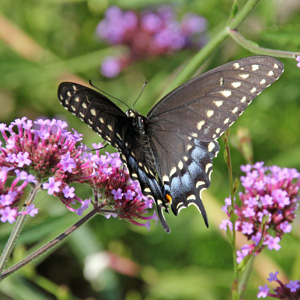
The black swallowtail – also called the eastern black swallowtail or American swallowtail and a variety of other colloquial names such as parsley worm – is a common butterfly found throughout much of North America. Papilio polyxenes is one of many species in the largest genus in the butterfly family Papilionidae (swallowtails). It ranges from southern Canada to northern South America, but is most common east of the Rocky Mountains. There are several subspecies that occur in Mexico, Central America and South America. It has been designated as the state butterfly of Oklahoma.

Adult black swallowtails are usually found in open areas, such as fields, meadows, parks, wetlands, prairies and sunny backyards. Females tend to be larger than the males, with a wingspan of 3¼ to 4¼ inches. The wings are black with yellow, blue, orange and red markings. On the upper surface there are two rows of yellow spots along the edges, with a powdery iridescent blue area between the two rows and a

red eyespot (red circle with a black bulls-eye) near the margin of each hind wing. The yellow spots are typically large and bright and the blue not very prominent on males, while females have smaller and lighter colored yellow spots but a prominent blue area (although some males have markings similar to females) – this difference is called sexual dimorphism.
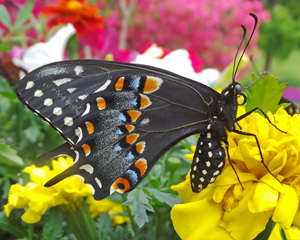
The underside of the wings has two rows of pale yellow spots on the edges of the front wings and bands of orange spots separated by pale blue on the hind wings. Both sexes have the characteristic narrow lobe on the hindwings, called the tail.
Although black swallowtails are fairly easy to identify, they are most likely to be confused with the pipevine swallowtail (Battus philenor), which is black with an iridescent blue-green sheen and only faint white spots on the upper surface and has only a single row of spots below, and the spicebush swallowtail (Papilio troilus), an uncommon stray into Wisconsin, which has white spots on the upper surface and the yellow spots on the underside are interrupted in the middle by a blue area. The underside of the wings mimics that of the poisonous and distasteful pipevine swallowtail which can fool vertebrate predators into avoiding eating them (Batesian mimicry). Since they spend a lot of time roosting with the wings closed, this maximizes the protective effects (the upper side of the wings of males doesn’t resemble that of the pipevine swallowtail).
Male butterflies emerge before the females and maintain and defend territories, where they perch and patrol for receptive female butterflies. Both sexes obtain nectar from a variety of flowers, including milkweed, thistles, purple coneflower, zinnias, and Verbena bonariensis. They will also visit moist ground to obtain salts.
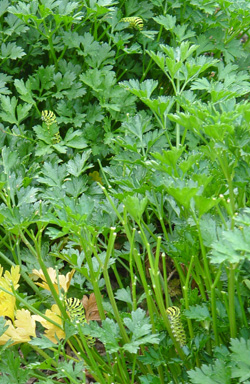
Larval host plants include a variety of species in the carrot family (Apiaceae). Cultivated dill, parsley, fennel, celery, caraway, and carrot are common food sources in backyard gardens, where it could be considered a pest. Usually they are not numerous enough to present a real problem. But for gardeners who do not want their plants eaten, handpicking would eliminate the problem in most situations. Insecticides are rarely justified, but if needed, foliar insecticides and the bacterial insecticide BT (Bacillus thuringiensis)
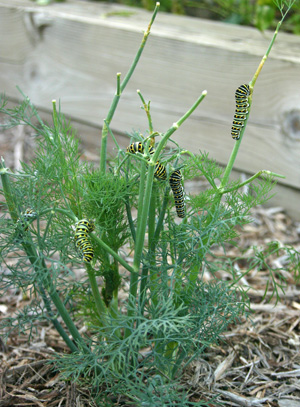
provide effective control. Black swallowtail will sometimes also utilize plants in the citrus family (Rutaceae), including common rue, Ruta graveolens. Wild plants that are utilized as larval food include introduced species such as Queen Anne’s lace (wild carrot, Daucus carota), poison hemlock (Conium maculatum), and wild parsnip (Pastinaca sativa) and native species including spotted water hemlock (Cicuta maculata) and golden alexander (Zizia aurea).

Females lay pale yellow, spherical eggs singly on host plants, usually on new foliage but occasionally on flowers. The eggs darken as the caterpillar develops inside. The eggs hatch in 3 to 9 days, with the caterpillar chewing its way out of the egg and then consuming the eggshell. The first instar larvae are spiny and mostly black with a whitish saddle, mimicking bird droppings. In the second and third instars the spines are reddish or orange.
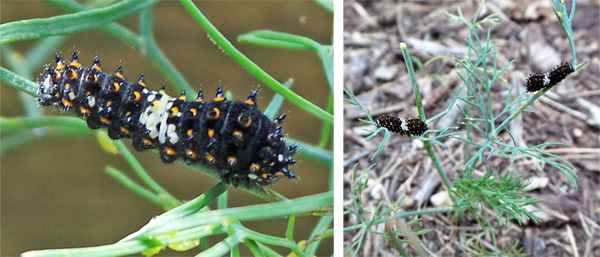
Older larvae (fourth and fifth instars) are green with transverse bands of black with yellow spots, a color pattern that likely makes them hard to see while resting on the sun-dappled host plants. The caterpillars eventually grow up to 1½ to 2 inches long. The larval stage takes 10 to 30 days depending on temperature and type of host plant.

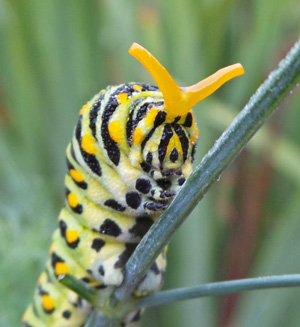
All swallowtail larvae have an eversible horn-like organ behind the head known as the osmeterium (osmeteria, plural) that looks like a forked snake tongue. It is a bright yellow-orange color on the black swallowtail. When the caterpillar is disturbed it rears up and the organ is extended for a short period of time. When everted it it releases a chemical repellent with a foul smell to repel predators. It is harmless to humans, however.
Once the caterpillar matures it wanders away from the host plants to find a place to pupate. It positions itself in the typical swallowtail “head-up” position on something such as a plant stem, tree trunk, foundation wall or other location and spins a slender silken band around the thoracic area to support itself and is attaches at the hind end to a silk pad by a Velcro®-like cremaster. It then molts one last time into a naked chrysalis (not inside a cocoon like moths make) with short horn-like protrusions on the head.
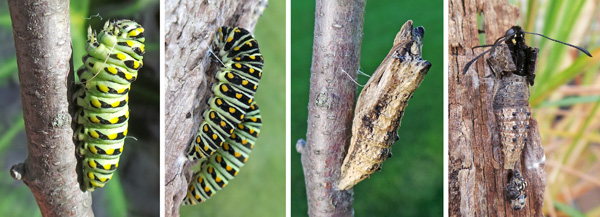
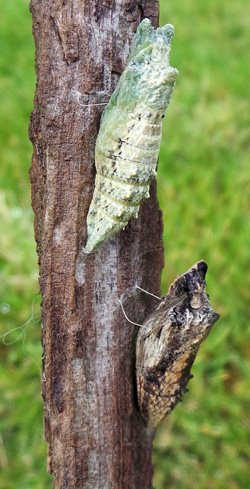
The color of the chrysalis is either greenish with yellow markings or mottled brown. This is determined genetically, not by the individual’s immediate surroundings, so that the majority of the pupae will blend in; overwintering pupae are always brown. This stage is very cryptic and not commonly seen in the garden. Those of the first brood will remain in the pupal state for 2 to 3 weeks, while later generations pupating in the fall will enter diapause and overwinter in the pupal stage. Adults emerge in the spring, generally eclosing in the morning. There are usually two generations in the upper Midwest, with adults generally flying from mid-May until late September. They are most numerous in early July until late August when the second brood adults are out. There is a third flight period in southern regions.

This insect may be parasitized in the larval or pupal stages by flies in the families Phoridae and Tachinidae, and by wasps in the families Braconidae and Ichneumonidae. Since some insect parasitoids find their hosts by the smell of volatile chemicals in insect frass, black swallowtail larvae use their mandibles to throw their fecal pellets off the plant so these natural enemies will be less likely to find them.
If you want to encourage black swallowtail to visit your garden, plant flowers to provide nectar to adults and larval host plants (such as dill or parsley that you are willing to let them eat), and refrain from using insecticides in the garden.
– Susan Mahr, University of Wisconsin – Madison





 ▶︎ Watch: Hydrangeas: Know Them and Grow Them
▶︎ Watch: Hydrangeas: Know Them and Grow Them ▶︎ Watch: Fall Bulb Planting
▶︎ Watch: Fall Bulb Planting Aster, Symphyotrichum spp.
Aster, Symphyotrichum spp. Fascinating Fasciation
Fascinating Fasciation


